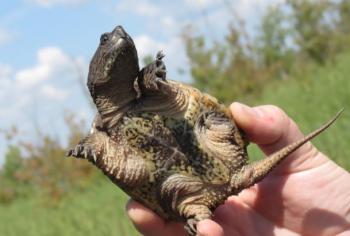Watch Out: Turtles Begin Nesting Season in SNC Jurisdiction

The first day of summer is finally approaching in South Nation Conservation’s (SNC) 4,384 square-kilometer jurisdiction in Eastern Ontario; the weather is warming, the sun is shining for longer, and turtles are on the move.
Beginning in the spring, female turtles will emerge from nearby bodies of water in search of suitable nesting sites; oftentimes they will cross busy roads in search of their preferred nesting habitat, frequently settling in gravel shoulders of roadways.
That’s why SNC is reminding residents to be on the lookout for our region’s beloved and endangered slowpokes when behind the wheel.
“It’s important to be aware of turtles on roadways at this time of year,” explains Karen Paquette, SNC’s Fisheries Technician. “Turtle Crossing signs serve as a reminder to slow down and watch out.”
The SNC jurisdiction is home to seven species of turtles, all of which are at risk due to nest depredation, habitat fragmentation and road mortalities.
Turtles may lay dozens of eggs while nesting, but most end up serving as food for raccoons, skunks, and other regional predators; only a small percentage of local turtles survive long enough to reproduce.
“Turtles are good indicators of a healthy and ecologically stable watershed,” added Paquette. “Continued efforts to protect turtles, and other species at risk, are critical to the longevity of these species and to protecting the local environment.”
SNC promotes the importance of protecting turtles and other species at risk through education and outreach; the Conservation Authority’s award-winning “Totally Turtles” bilingual education kit supplements the Ontario curriculum and can be loaned out to local teachers.
SNC also reminds residents not to touch turtles in their natural environment, and to help turtles across roadways only if it’s safe to do so. Local turtle sightings can be reported directly to Ontario Nature’s Reptile and Amphibian Atlas at www.ontarionature.org.
“If you must move a turtle for its safety, never drag it or pick it up by its shell, tail or limbs,” says Paquette. “It’s best to pick up a turtle using both hands, one on each side of its body, between its front and back legs, and to bring it into the direction that it’s headed.”
FOR MORE INFORMATION: Karen Paquette, Fisheries Technician, 1-877-984-2948, ext. 286, kpaquette@nation.on.ca
###

